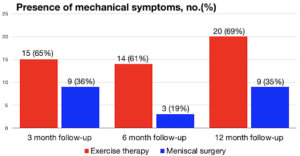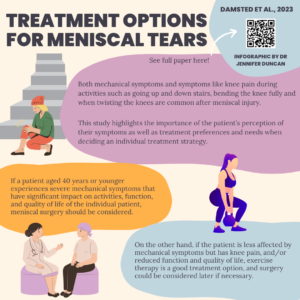Keywords: Knee; Mechanical symptoms, treatment
Why is this study important?
Knee arthroscopy is commonly used to treat meniscal tears in young adults; a common condition with great personal and societal burden. Recently, two studies where patients were allocated to surgical or non-surgical treatment by chance (i.e. a randomized controlled trial) found no difference in patient-reported outcomes between young patients treated with meniscal surgery compared to a strategy of exercise therapy, with the option of later surgery if needed (1) (2). These results suggest that both surgery and exercise therapy are viable treatment options for this patient group, but that surgery may not be necessary if starting with exercise therapy.
In patients with meniscal tears and mechanical symptoms (e.g. sensation of catching and/or locking of the knee), surgery is still preferred over exercise therapy, as surgery is believed to relieve these symptoms by removing trapped pieces of damaged meniscal tissue causing these symptoms. But so far, this assumption has not been backed by research, as no studies have compared the effect of surgery with exercise therapy in alleviating mechanical symptoms for young patients with meniscal tears.
The aim of this study was to compare the effect of early meniscal surgery with exercise therapy (with the option of later surgery) in alleviating patient-reported mechanical symptoms in patients aged 18-40 years with a meniscal tear (3). In addition, we also compared the 12-month effect of the two treatment strategies on patient-reported knee pain, knee function and knee-related quality of life
How did the study go about this?
A randomized controlled trial included 121 patients aged 18-40 years with a meniscal tear that was verified on imaging. Participants were randomized into 1 of 2 groups: surgery or 12-weeks supervised exercise and education. For this study, 63 patients (33 and 30 patients in surgery and exercise groups, respectively) reporting mechanical symptoms at the beginning of the study were included. To assess the effect of the two treatment strategies, patients were asked after 3, 6 and 12 months if they still had mechanical symptoms, and further, asked about their level of knee pain, knee function and knee-related quality of life.
What did the study find?
Our results suggest that early surgery may be more effective for alleviating patient-reported mechanical knee symptoms in young patients with a meniscal tear and mechanical symptoms compared with a strategy of exercise therapy and patient education. This is visualized in the figure below, showing that the proportion of patients reporting mechanical symptoms were higher in the exercise therapy group at all follow-up timepoints.

However, after 12 months both treatment strategies resulted in similar meaningful improvements in knee pain, knee function and knee-related quality of life.
What are the key take-home points?
Both mechanical symptoms and symptoms like knee pain during activities such as going up and down stairs, bending the knee fully and when twisting the knees are common after meniscal injury. This study highlights the importance of including the patient’s perception of their different symptoms as well as treatment preferences and needs when deciding an individual treatment strategy. If a patient aged 40 years or younger experiences severe mechanical symptoms that have significant impact on activities, function, and quality of life of the individual patient, meniscal surgery should be considered. On the other hand, if the patient is less affected by mechanical symptoms but has knee pain, and/or reduced function and quality of life, exercise therapy is a good treatment option, and surgery could be considered later if necessary.

Authors:
Camma Damsted PT, Ph.D. 1,2; Jonas Bloch Thorlund PhD.1,8 , Søren T. Skou PT, PhD. 1,2 for the DREAM Study Group.
The authors would like to acknowledge the rest of the author group for their contribution to the present study:
Per Hölmich MD, DMSc 3; Martin Lind MD, PhD 4; Claus Varnum PhD 5; Martin Dalgaard Villumsen, Ph.D 6 and Mogens Strange Hansen MD, PhD 7
1 Research Unit for Musculoskeletal Function and Physiotherapy, Department of Sports Science and Clinical Biomechanics, University of Southern Denmark, Odense, Denmark
2 The Research Unit PROgrez, Department of Physiotherapy and Occupational Therapy, Næstved-Slagelse-Ringsted Hospitals, Denmark, Region Zealand, Slagelse, Denmark
3 Sports Orthopedic Research Center – Copenhagen (SORC-C), Department of Orthopaedic Surgery, Copenhagen University Hospital, Amager-Hvidovre, Copenhagen, Denmark
4 Department of Orthopedics, Aarhus University Hospital, Aarhus, Denmark
5 Department of Orthopaedic Surgery, Lillebælt Hospital Vejle, Vejle, Denmark
6 Department of Sports Science and Clinical Biomechanics, University of Southern Denmark, Odense, Denmark
7 Elective Surgery Centre, Silkeborg Regional Hospital, Silkeborg, Denmark
8 Research Unit for General Practice, Department of Public Health, University of Southern, Denmark, Odense, Denmark
References:
- Skou ST, Hölmich P, Lind M, et al. Early Surgery or Exercise and Education for Meniscal Tears in Young Adults. NEJM Evidence 2022;1(2):EVIDoa2100038. doi: doi:10.1056/EVIDoa2100038
- van der Graaff SJA, Eijgenraam SM, Meuffels DE, et al. Arthroscopic partial meniscectomy versus physical therapy for traumatic meniscal tears in a young study population: a randomised controlled trial. Br J Sports Med 2022 doi: 10.1136/bjsports-2021-105059 [published Online First: 2022/06/09]
- Damsted C, Thorlund JB, Hölmich P, Lind M, Varnum C, Villumsen MD, Hansen MS, Skou ST. Effect of exercise therapy versus surgery on mechanical symptoms in young patients with a meniscal tear: a secondary analysis of the DREAM trial. Br J Sports Med. 2023 May;57(9):521-527. doi: 10.1136/bjsports-2022-106207. Epub 2023 Mar 6. PMID: 36878666.